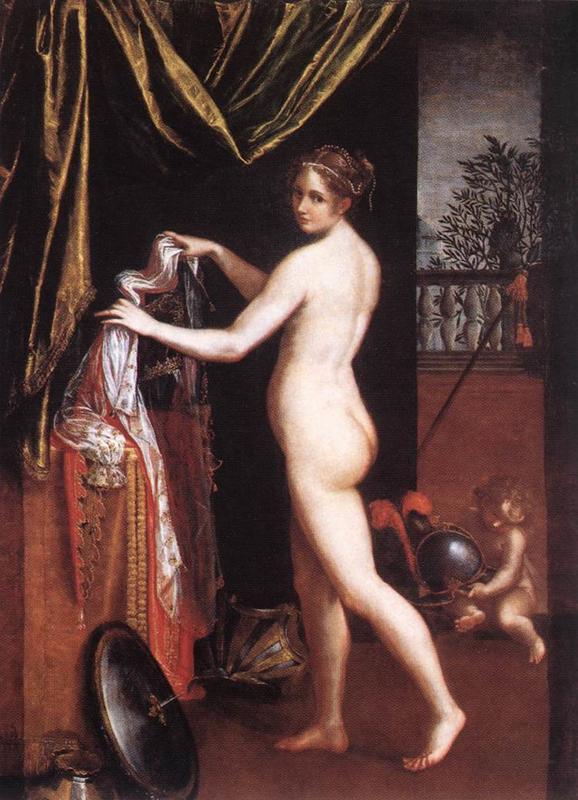More about Minerva Dressing

Contributor
We know why you clicked this link; you wanted to see some ancient goddess tushy and we can’t judge you for that.
But there is way more behind the butt, so to speak, in this painting.
Minerva Dressing was the last painting that Lavinia Fontana finished before she died and I think that it is no coincidence that it embodies her character to a T. Fontana was an OG Lady Boss. She was breaking gender norms left and right in the mother-fing 16th century; now, that’s badass. She followed her father, Prospero Fontana, in his footsteps and became a celebrated painter quite young. When she and a fellow art pupil, Gian Paolo Zappi, fell in love and married not only did she not give up her career, Zappi believed in her talent so much that he became HER assistant and raised their eleven children (they were obviously very “busy” in the art room). But popping out almost a dozen little rugrats didn’t slow down Fontana one bit.
Over the course of her painting career, Fontana finished over 135 paintings and acquired astonishingly famous patrons for a woman painter, such as Popes Gregory XIII, Clement VII, and Paul V. She was even appointed ‘portrait ordinary’ for the Vatican by Pope Gregory XIII and personally asked to move to Rome by Pope Clement VIII. Upon arriving in Rome, she was the first woman EVER to be accepted into Rome’s Accademia di San Luca, which served as a school/brotherhood for painters, sculptors, and architects in the city. However, despite all of her overwhelming accomplishments, Fontana was still restricted by her gender as to the subjects that she was allowed to paint. She was not allowed to study or paint the male nude form; however, she was allowed to paint nudes of women, which she did heartily. She painted several series of nude portraits of Greek goddesses and allegories such as Venus and the female personification of Prudence.
Towards the end of her life, Fontana became especially fascinated with the goddess Minerva. I wonder if she saw the distinct similarities between their strong and willful personalities. For those readers who aren’t as familiar with mythology, Minerva is the Roman goddess of wisdom, the arts, war strategy, and commerce. The Romans based much of Minerva's power and lore on the Greek goddess, Athena. She was similarly born from her father, Jupiter’s, head and is depicted wearing armor with a wise, stern face. Minerva was believed to be the personification of the power of thought and strategic victory; so basically, you really wanted to be on her good side.
In the 16th century, if a woman was able to scrape out even a little achievement, it was through well-planned strategy and strength of mind. In Roman myth, people lead by the goddess Minerva earned their victory through perseverance and wit. Lavinia Fontana not only courageously pushed the boundaries of ‘a woman’s place’ but she also knew the importance of having allies in high places. I think she would have received Minerva’s stamp of approval.
Sources
- https://www.wga.hu/html_m/f/fontana/lavinia/minerva.html
- https://www.wga.hu/bio_m/f/fontana/lavinia/biograph.html
- https://www.highbeam.com/doc/1G1-464162808.html
- https://www.ancient.eu/Minerva/
- https://www.britannica.com/topic/Minerva-Roman-goddess
- https://pantheon.org/articles/m/minerva.html
- https://www.highbeam.com/doc/1G1-166945182.html
- https://www.nga.gov/accademia/en/intro.html











